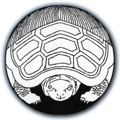First up, thanks to Village Books in Bellingham for a great reading venue on Friday! You are a very cool bookstore, and Bellingham is a very happening book town.
Now, some news from home. Just got word that our Silkies have hatched out the first chicks of the season. The first clutch, in early March! This breed is phenomenally prolific. They’re an ancient Chinese chicken, first introduced to Europe by Marco Polo, and prized in China for their docile nature and the health-giving properties of their meat. Their feathers are downy-soft, and come in different colors, some blue, some buff, some black. Underneath, their skin is black, and they have brilliant sapphire spots on their cheeks, and fluffy puffs on the tops of their heads, like little pillbox hats, which make them look like mod fashion models from the Sixties. Okay, maybe that’s stretching it.
The secret to their long survival is their implacable maternal instinct. These hens will go broody at the drop of a hat. They’ll sit on a stone and try to hatch it. Even the roosters will hunker down on a clutch of eggs.
Isn't it amazing, that the same egg that we scramble and eat for breakfast can, in a mere 21 days, organize itself from a liquid yolk and a tiny spot of blood into a living, breathing, peeping, self-propelling organism, with an appetite, and a will to continue? From a single large cell, to a complex, multi-cellular life form, in 21 days! Not to make you feel bad or anything, but think back on the last three weeks of your life. What have you managed to accomplish? Even with these great big brains of ours, in our high-tech labs, we still can’t begin to replicate something that a chicken does with such casual off-handedness. I mean, it takes me years to write a novel. In 21 days, I might write a page or two, or twenty, but it’s still only words, marks on paper, like the scratching of a chicken. It doesn’t have a beating heart.
Of course, since chicken brains are about the size of a bean, they come up short in the imagination department. This is some consolation.
Here’s a question that I’ve always found puzzling. I’m sure there’s a simple answer, but I don’t know what it is, and I’ll send a free book to the first person who can clue me in:
I’ve read that if you weigh a fertilized chicken egg that’s just been laid, and you weigh it again just before it hatches, it will be heavier, which makes sense because it has a whole baby chick inside with bones and muscles and body mass. But where does all that mass come from? Not from the mother, clearly, because there’s no umbilical connection, therefore no material transfer. The egg is a closed system, so how does that additional matter get into the shell? It can’t come from nowhere, because according the Law of Conservation of Mass, in a chemical reaction, matter can neither created nor destroyed; it can only change it’s form. Clearly, an embryo changes form, but how do you explain the increase in mass? Where, for example, does the calcium come from?
